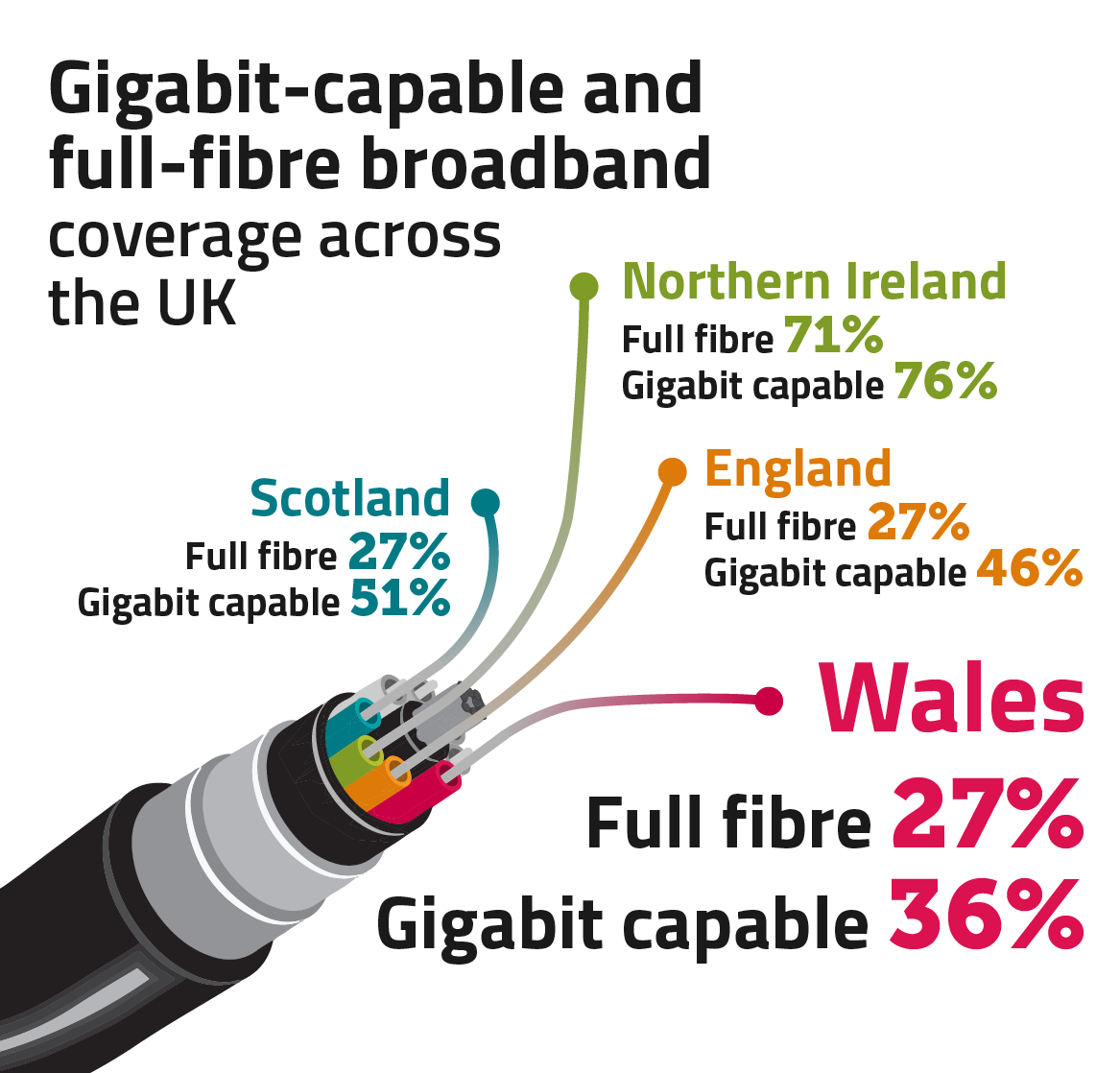
- Full-fibre broadband now available to more than 400,000 homes, as rollout accelerates
- Thousands have already boosted their broadband, but many others yet to take advantage
- Properties without access to decent broadband falls to lowest ever level, but more to do to get hardest-to-reach homes connected
Fast, reliable internet connections are now available to more people than ever before, allowing thousands of homes in Wales to access the content they want, quickly, including downloading their favourite Christmas movie in less than a minute.

Ofcom’s annual Connected Nations Wales report – on the availability of broadband and mobile services in Wales – reveals that the rollout of future-proof, full-fibre technology is accelerating at its fastest ever rate.
More than 400,000 homes in Wales (27%) can now get full-fibre broadband – an increase of 8 percentage points on last year and in line with the UK average. Take-up of full-fibre broadband in Wales is also in line with the UK average at 24%.
By September 2021, Gigabit-capable coverage was at 36% of premises (0.5 million) in Wales and this has increased further since the completion of Virgin Media O2’s network upgrade. This includes full-fibre and upgraded cable networks that are capable of delivering download speeds of 1 Gbit/s or higher.
As well as delivering faster download speeds, these services offer faster upload speeds and are more reliable than older broadband technologies.
The availability of superfast broadband in Wales remains stable at 94% and despite an uplift during the past year, take-up of these services by consumers in Wales is slightly below the UK average at 63%.
Why would I need full fibre?
Full-fibre connections – along with upgraded cable networks – can deliver download speeds of up to 1 Gbit/s.[1] At this speed, families with full-fibre services could download one of their Christmas film favourites in High-Definition in less than a minute, compared with around 25 minutes for those with superfast broadband (30 Mbit/s).

Full fibre can better support data-hungry households where family members need to stream, work, game, video-call and study online at the same time. And in a year when many people continue to work from home due to the coronavirus pandemic, average monthly data use across the UK grew to 453 GB per connection - more than treble what it was five years ago (132 GB).
Connecting the hardest to reach households
There are still around 15,000 homes and businesses (1%) in Wales without access to a ‘decent’ broadband service of at least 10Mbit/s download speed and 1Mbit/s upload speed from either fixed or fixed wireless networks. At this speed, it could take up to an hour and a half to download an HD film.
These properties may be eligible for a connection under the broadband Universal Service Obligation (USO) and if so, would get access to full-fibre broadband. This figure has reduced from 18,000 premises in our 2020 report.
Full fibre is helping meet the increasing demands of consumers, with thousands more benefitting from faster speeds and more reliable connections. But some homes in hard-to-reach areas still struggle to get decent broadband and there is more work to do to make sure these communities get the connections they need.
Ofcom is playing its part in this process and is supporting the Welsh Government’s Barrier Busting Taskforce in its work of trying to ensure that consumers are aware of what services are available to them and from which communications providers. We believe that a better understanding of available services and providers will help drive take-up of faster, future-proofed fibre services.
Eleanor Marks, Ofcom’s Director, Wales
4G coverage remains stable as 5G begins its roll out in Wales
Mobile coverage is generally stable – 90% of Wales has access to good 4G geographic coverage from at least one of the mobile operators and 61% has coverage from all four operators. Good 4G coverage varies considerably between local authorities in urban and rural parts of Wales. Gwynedd and Conwy have the lowest levels of coverage from all operators at 46%, followed by Powys at 49%.
Call and text services from all four operators are available across 78% of Wales’ landmass. The Shared Rural Network programme agreed between the Mobile Network Operators and the UK Government in March 2020 will extend coverage beyond this by 2025.
5G rollout continues to gather pace, with the number of mobile base stations providing 5G services in the UK more than doubling over the last year, to over 6,000 sites. 87% of these are in England, 8% in Scotland, 3% in Wales and 2% Northern Ireland and are predominantly located in densely populated urban areas.
Connectivity remains poor in some of the hardest to reach areas in Wales. Call and text total not-spots account for 5% of Wales’ landmass. We estimate that around 7,850 premises in Wales cannot access either a decent fixed broadband service or get good 4G coverage indoors. Almost all these properties are in rural parts of Wales.
Notes to editors
- An interactive version of the report, also published today, allows people to look up how coverage compares in their area.
- The International Broadband Scorecard compared broadband availability and take-up across 17 different nations.
- Improving your wifi experience
- Estimated download speeds used in the Elf graphic are indicative
